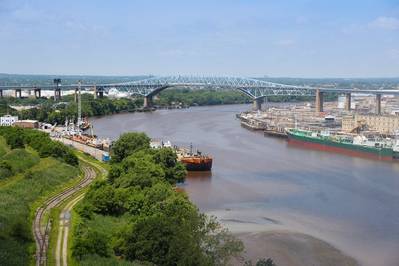On February 12, President Trump released his highly anticipated infrastructure proposal, a “Legislative Outline for Rebuilding Infrastructure in America.” Unlike prior federal infrastructure development strategies, which rarely discussed the need for maritime infrastructure investment, the proposal places maritime infrastructure on equal footing with other surface transportation modes in terms of potential funding opportunities.
The outline contains proposals that would create three new major programs, expand the availability of existing programs and apply reforms aimed at improving overall investment in maritime infrastructure, as well as project delivery. While the administration’s inclusion of maritime infrastructure in its proposal represents an important first step, maritime stakeholders – including deepwater ports, inland ports, marine terminal operators, shippers and ocean and inland carriers – will need to remain engaged to ensure that their interests are represented in any infrastructure legislation that follows.
Three New Major Funding Programs
At the heart of the proposal are three new programs – an Incentives Program, Rural Infrastructure Program and Transformative Infrastructure Program – that would be open to maritime infrastructure-related projects, including deepwater ports, inland ports, locks and dams. The three programs, supported with a proposed total of $170 billion in federal funding are aimed at repairing the nation’s crumbling infrastructure and at building new infrastructure to meet the demands of the growing economy.
$100 Billion Incentives Program
- The goal of the incentives program is to spur investment by state and local governments and the private sector.
- Portions of these funds would be distributed to and administered by the Department of Transportation (DOT), U.S. Army Corp of Engineers (USACE) and the Environmental Protection Agency (EPA).
- Prior infrastructure grant programs contained a similar division of authority – with DOT providing oversight of grants for surface transportation elements within the port and USACE overseeing any development beyond the water’s edge.
- Federal grants from the program would fund up to 20 percent of new revenue for a project.
- Grant applications would be evaluated on a six-part test that focuses on financing strategy, new technology, and economic benefit – heavily weighted toward projects where the applicant demonstrates the ability to secure new non-federal revenue.
- The overall aim is to promote public-private partnership investments in infrastructure, including the revitalization of locks, dams and ports.
$50 Billion Rural Infrastructure Program
- 80 percent of this $50 billion would be distributed by formula to governors for use in their states. The other 20 percent would be distributed by competitive (performance) grants.
- Infrastructure projects related to inland ports, dams, locks and other navigation infrastructure in rural areas would be eligible for these funds.
- The proposal does not define what would constitute a rural project, however, prior federal programs were used to develop rural port infrastructure – including entirely new barge ports – on inland waters to alleviate barge congestion at major metropolitan port facilities.
$20 Billion Transformative Projects Program
- Funding under this program would be available under a staggered structure based upon phases in the project: up to 30 percent of eligible costs for demonstration, up to 50 percent of eligible costs for project planning and up to 80 percent of eligible costs for capital construction.
- This fund focuses specifically on fundamental transformation of the way infrastructure is delivered or operated, including federal funding and technical assistance for projects that possess unique technical and risk characteristics that would deter private sector investment – such as improvements to lock networks or dams.
- Applicants selected for award under this program would enter into a partnership with the federal government.
- For the maritime sector, this presents an opportunity to introduce not only new infrastructure but new technology into the movement of cargo.
Enhancements to Existing Programs and Financing Options
In addition to introducing new financing programs, the proposal seeks to modify existing federal credit programs of significance to the maritime sector with a proposed modification to the Transportation Infrastructure Finance and Innovation Act (TIFIA) and the Water Infrastructure Finance and Innovation Act (WIFIA). TIFIA and WIFIA, which provide credit assistance through a combination of loans, loan guarantees and lines of credit to qualified public or private borrowers, including state governments, private firms, special authorities, local governments, transportation improvement districts or a consortium of these entities such as public‐private partnerships, currently have limited applicability to the maritime sector. The proposed modifications have the potential to substantially change the applicability and ease of use by the maritime industry to support infrastructure investment.
Specifically, proposed modifications to TIFIA include providing additional budget authority and making TIFIA loans and other credit assistance available for nonfederal port infrastructure enhancement and expansion projects. Currently, TIFIA is available only for the “surface transportation” elements of port infrastructure projects. This programmatic expansion may allow ports to finance dredging or stand-alone equipment (e.g., reachstackers, mobile harbor cranes) that currently may be ineligible under TIFIA.
Proposed modifications to WIFIA include providing additional budget authority, expanding eligibility to flood mitigation and navigation and making a number of changes to streamline the application process and cost to project sponsors.
The White House proposal also creates flexibility and broadens eligibility for use of Private Activity Bonds (PABs). PABs, which are bonds issued by or on behalf of state or local governments to support the financing of private use projects that have a public benefit, are a key tool to attract and leverage private investment due to their federal tax exemption. Under existing law, the use of PABs in the maritime context is limited to the development of “docks and wharves” and certain associated training and storage facilities. Under the new proposal, however, PABs could also be sold to finance any “maritime and inland waterway ports, and waterway infrastructure, including dredging and navigation improvements.” This potentially represents a remarkable turnaround from just a few months ago when PABs for all infrastructure projects risked losing their tax-exempt status under prior iterations of the Tax Cuts and Jobs Act.
Additional Reforms
In addition to the new and expanded financing mechanisms that would be available to support investments in maritime infrastructure, the proposal makes recommendations for other significant reforms that would have an impact on the industry.
Reform #1: Permitting
The proposal provides insight into how the administration plans to streamline and improve the permitting process for infrastructure projects. The administration plans to do this through a three-prong approach that would: (1) create a new, expedited structure for environmental reviews; (2) delegate more decision-making to states and enhance coordination between state and federal reviews; and (3) authorize pilot programs through which agencies may experiment with innovative approaches to environmental reviews while enhancing environmental protections. For example, it establishes a “One Agency, One Decision” environmental review structure – giving lead agencies 21 months to complete an environmental review and an additional three months to make decisions with respect to necessary permits, as opposed to project sponsors having to navigate the permitting processes with multiple federal agencies with separate decision-making authority. This change would be advantageous to ports seeking approval for projects containing both in-water and surface transportation elements, which currently require environmental reviews by multiple federal agencies.
Reform #2: User Fees
The White House also calls for greater flexibility to impose and retain user fees in order to incentivize the development of effective and efficient water infrastructure for up to 10 projects. Currently, with limited exception, user fees collected on the waterways are returned to the Treasury and are not reinvested in the locations where they were collected. In contrast, the proposal would allow the government and third-party service providers to charge and retain fees or tolls for the operation and maintenance of the locks, dams and other navigable waterways where they are collected. The user fee model has, of course, been used to great effect in financing surface transportation projects, and this reform has the potential to bring that same benefit to maritime infrastructure projects.
Reform #3: Federal Assets
The proposal calls for changes to allow the sale of federal assets that could be more appropriately owned, operated and maintained by state, local or private entities. The plan would allow the government to take assets no longer needed by any federal agency directly to market without going through the current system of at least 12 public benefit conveyance requirements. This would make it easier for private entities to acquire public maritime infrastructure and manage resources. With dams, hydroelectric plants and locks under federal control across the country, this plan presents an opportunity for private investment.
Reform #4: USACE Contracting Authority
To further support the development of non-federal partner participation in water infrastructure, the proposal would also grant USACE the authority to engage in longer-term contracts. The proposal specifically calls for an extension from the current limit of five years to as many as 50, allowing more time for non-federal partners to see a full return on investment. For example, under the proposal a private investor could (1) receive a low-cost loan under WIFIA to reconstruct a lock or dam, (2) receive a 50-year contract from USACE to operate that lock or dam, and (3) collect user fees directly from users of that infrastructure – making long-term private investment in such infrastructure projects more attractive.
Reform #5: Workforce Development
The administration’s infrastructure proposal also contains several measures aimed at workforce development, including expanding Pell Grant eligibility for individuals who are in skilled trades or apprenticeships and expanding the federal work study program to include coverage for more internships in focus areas related to a student’s college major. In the maritime sector, this means the potential for a better-trained workforce across the industry in direct operations and support services both on the shore side and water side.
The release of the Legislative Outline for Rebuilding Infrastructure in America represents a key step in shaping the future of infrastructure investment in the United States. Crucially, the inclusion of maritime projects in the outline is demonstrable evidence that the infrastructure needs of deepwater ports, inland ports, marine terminal operators, shippers and ocean and inland carriers are being considered by the executive branch. Building on this foundation, maritime stakeholders must now ensure that their infrastructure needs receive appropriate congressional consideration.
The Authors
Howard Schweitzer is the managing partner of Cozen O'Connor Public Strategies.
Robert Freeman is a government relations principal with Cozen O’Connor Public Strategies.
Jeff R. Vogel is a partner in Cozen O’Connor’s Maritime Regulatory practice.
















